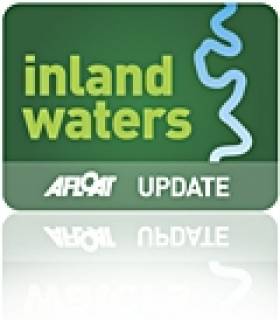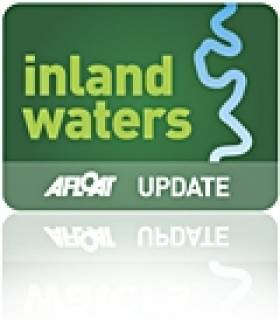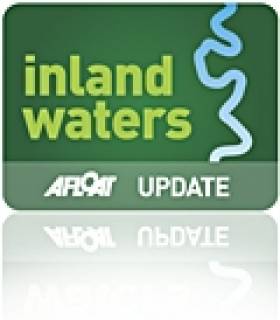Displaying items by tag: Inland
Erne Navigation Closure of Jetty at Crom
MARINE NOTICE
No 2 of 2014
Erne Navigation
TEMPORARY CLOSURE OF PUBLIC JETTY AT CROM
The public mooring jetty at Crom on Upper Lough
Erne is now closed for improvement work until
Mid-March 2014.
Waterways Ireland regrets any inconvenience that this may cause to its customers.
For further details please contact:
Lough Erne Warden on +44 (028) 6632 2836
Charles Lawn
Inspector of Navigation
The Docks,
Athlone,
Co.Westmeath
+353906494232
09 Jan 2014
Tel: 353 90 6494232
Fax: 353 90 6494147
#byelaws – Waterways Ireland invites people and organisations affected by the changes to the Draft Canals Act, 1986(Amendment) Bye-Laws, 2014 to make submissions to Waterways Ireland before the 3rd February 2014.
All the documents are available online and can be viewed by arrangement in Waterways Ireland offices in Enniskillen and Dublin. Submissions can be made online, by email, by post and by visiting Waterways Ireland offices.
Submissions are being sought on changes to the Bye-Laws on the Grand Canal, Royal Canal and Barrow Navigation. The Draft Canals Act, 1986(Amendment), Bye-Laws, 2014 includes a new management framework which will be used to manage continuous cruising, houseboats, dry dock facilities as well as key location & serviced mooring usage. The amendments also include changes to mooring times, charges and the introduction of a fixed penalty notice.
Waterways Ireland will consult with the groups representing the views of people affected by statutory equality regulations such as disability or age based groups. In addition Waterways Ireland will be holding meetings with groups where their members will be affected by the changes to the Bye-Laws. Letters have also been issued to all permit holders on the navigations affected by the Bye-Law changes informing them of the public consultation and the availability of the documentation.
The period for submissions is set by the Section 7(1) of the Canals Act, 1986 (No.3 of 1986) as amended by section 56 of the Maritime Safety Act, 2005 (No. 11 of 2005). The deadline for submissions is the 3rd February 2014. Documentation is available from www.waterwaysireland.org/Public-Consultation or from Waterways Ireland offices as listed.
Shannon Navigation Shoal Area Reported at Lough Ree Inchturk Island
MARINE NOTICE
No. 101 of 2013
SHANNON NAVIGATION
Lough Ree
Inchturk Island
Shoal Area Reported.
Waterways Ireland wishes to advise masters and owners that a shoal area has been reported approximately 100ft / 30m north of the starboardhand mark at the northern end of Inchturk Island.
Masters are requested to give this mark a wide berth until further notice.
Charles Lawn
Inspector of Navigation
15 Aug 2013
Tel: 00 353 (0)90 6494232
Fax : 00 353 (0) 6494147
MARINE NOTICE
No. 97 of 2013
Royal Canal - Dublin
Towpath Closure
Level 1 – Binns Bridge to Russell St
Waterways Ireland wishes to advise that the above section of canal towpath on Level 1 of the Royal Canal Dublin has been closed to the public due to a wall slippage that occurred following heavy rainfall on Wednesday night.
Electrical and gas services run along the towpath so it has been closed as a precautionary measure until repairs are carried out. However, navigation will remain open as normal throughout this period.
Waterways Ireland apologises to its customers for any inconvenience caused.
C. Lawn
Inspector of Navigation
28 Jul 2013
Tel: 00353906494232
Fax:003539094147
MN81: Shannon-Erne Waterway Inspection of Weirs
MARINE NOTICE
No 81 of 2013
Shannon-Erne Waterway
Underwater Inspection of Weirs
Waterways Ireland wishes to advise masters of vessels that underwater inspection of weirs at Lock 1 Corraquill, Lock 3 Skelan, Lock 4 Aghoo and Lock 5 Ardrum shall commence Wednesday 10 th July and be completed on Friday 12 th July.
Masters approaching weirs should be prepared to stop short and await instructions from the dive safety officer before proceeding.
Waterways Ireland thanks its customers for their cooperation in this matter.
C.J.Lawn
Inspector of Navigation
3 Jul 2013
Tel: 353 90 6494232
Fax: 353 90 6494147
MN67: Shannon Navigation Lough Ree Sunken Vessel
MARINE NOTICE
No. 67 of 2013
SHANNON NAVIGATION
Lough Ree
Sunken Vessel
Waterways Ireland wishes to advise masters and owners that a sunken vessel is located approximately 100meters west of Hexagon Shoal on the Navigation Channel.
Masters are requested to navigate with due care in this stretch of the navigation.
C.Lawn
Inspector of Navigation
17Jun 2013
Tel: 00 353 (0)90 6494232
Fax : 00 353 6494147
Masters and users of the Shannon Navigation are advised that the Athlone Boat Club rowing regatta will take place on Sat 15th June from 0800 hrs until 1900 hrs, on Killinure Lough.
Masters are requested to proceed at slow speed and with minimum wash when in this area to avoid any upset to rowing craft which have only a small amount of freeboard.
Masters are further requested to note any advice given by race marshals when approaching the course.
Laying and removal of the course will take place between 9th and 18 Jun.
#waterways – Waterways Ireland's new website has been launched by Minister Deenihan and Martin Cullen, Head of Microsoft Ireland on Thursday 18th April 2013 in the Waterways Ireland Visitor Centre in Dublin's Ringsend
The new website www.waterwaysireland.org aims to actively recruit people into waterside recreation through attractive, functional activity pages, sharing information and club & activity centre contacts on every waterway.
Waterways Ireland supports over 100 events a year on the inland waterways and these events, plus loads of others appear in a searchable events section. Additionally it also enables related businesses & event organisers to upload their information so that it can be more effectively promoted and shared with the public.
Minister Deenihan at the launch confirmed his support stating "Waterways Ireland has developed a user friendly and attractive website as part of its marketing plan and is engaging meaningfully with business and the community to maximise the opportunities available. Increasing recreational use of our waterways has a social, health and economic benefit and this website is a key tool to assist Waterways Ireland in achieving it."
Additionally Waterways Ireland has grasped the potential of social media and begun the process of meeting the needs of the recreational waterway users, local communities and tourists through Facebook and Twitter.
Éanna Rowe, Head of Marketing & Communications, Waterways Ireland assured "Waterways Ireland is delighted to be able to provide more information and services online through this new website. Waterways Irelands aims to attract increasing numbers of people to our canals, rivers and lakes, because of the considerable economic and social impact on communities, villages and towns all across this island. In many instances the waterways are the only economic driver and a backbone of the community. The tactics used by Waterways Ireland through the new website and other marketing tools are all aimed at maximising the opportunities available for business and community."
Waterways Ireland developed the website in conjunction with Etain Software and Microsoft Ireland.
Protection of Breeding Birds at Bushy Island, Lough Derg
#breedingbirds – Waterways Ireland has been advised that protected birds are present and breeding on Bushy Island, Lough Derg.
To protect and minimise disturbance to nesting birds in the area, Masters of vessels are requested to observe a voluntary exclusion zone by not encroaching within 250m of the island and to proceed directly in and out of the harbour without stopping near the island, particularly between the months of April and August inclusive.
Masters should note that deliberate disturbance to nesting birds is illegal under the Wildlife Act (1976).
Minister Seeks Directors for Inland Fisheries Board
#inlandfisheries – The Minister for Communications, Energy and Natural Resources, Mr. Pat Rabbitte T.D., is inviting expressions of interest from suitably qualified and experienced persons interested in being appointed to the inland fisheries board.
The Board of directors performs key roles in relation to the direction, leadership and corporate governance of each State body. While the diversity of roles and responsibilities of individual bodies precludes a uniform list of characteristics or skills for prospective directors, those expressing interest in serving on the board of a State body should (in addition to any criteria specified in the statutes governing individual bodies) have demonstrable competence, knowledge or experience at a senior organisational level and/or recognised management experience and/or skills (e.g. law, finance, etc.) in a company/organisation.
By submitting an expression of interest the applicant accepts that appointments are made in the exercise of a statutory discretion, that the Minister is not obliged to consider the expressions of interest offered, that he is not confined to making an appointment from amongst those who have expressed an interest and is not bound by any statement set out in the notice. Vacancies on boards of such bodies can arise due to the conclusion of the period of appointment of Board members or as casual vacancies arise. Expressions of interest will be kept on file and considered as appointments arise.
Expressions of interest, including a curriculum vitae and a statement of suitability, should be sent by email to: [email protected] and should indicate the State Board s/he wishes to apply for, provide a brief outline of skills, competencies and qualifications and a short statement outlining why s/he wishes to be considered for a position on the board. The Department will acknowledge receipt of such applications.






































































